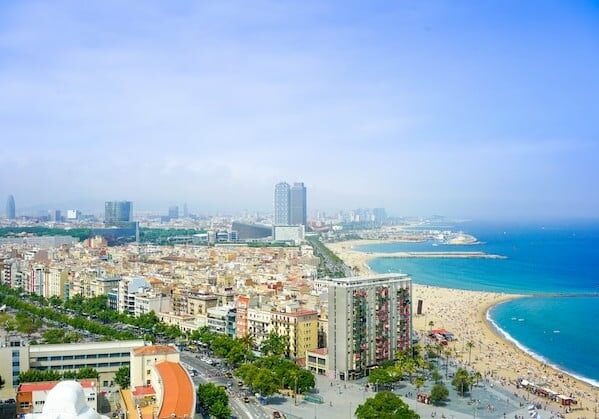Are you considering moving to Spain from US and unsure how? An increasing number of Americans are choosing to move to Spain, primarily attracted by the country’s warm climate, affordable cost of living, vibrant culture, and relaxed lifestyle; however, to live in Spain for more than 90 days, US citizens need to obtain a visa and residency permit, with popular options including the non-lucrative visa for retirees or those with independent income, or a work visa for employment opportunities.
Multiple options exist for an American citizen to move to Spain permanently and enjoy a peaceful life in Spanish culture. Numerous US expats already living in Spain vouch for investment as a route to permanent residence through the Golden Visa.
A Spain Golden Visa allows Americans and their family members to renew their visas and apply for permanent residency after five years, which can later lead to Spanish citizenship and freedom of movement in the European Union. This way, you can travel through other European countries freely.
This article will present the details of moving abroad to Spain and explore the choices available to American citizens and other non-EU nationals pursuing their Spanish dreams.
Reasons for Moving to Spain

Located in Southern Europe, residents living in this democratic country are blessed with sunny weather and a stress-free Mediterranean way of life. The high standard of living, excellent healthcare facilities, low crime rates, and low cost of living are some of the more influential reasons for its large expat community.
Since the launch of the Spanish Golden Visa, also known as the Investor Visa, program and the current strength of the American dollar against the Euro, more and more American citizens have been capable of investing in Spain or qualifying for other residency options, like the Spain Non-Lucrative Visa.
Acquiring a Spanish residence permit increases eligibility for obtaining Spanish citizenship and like other EU countries offering Golden Visas, the Spanish government has simplified the path to permanent residency. For a large and stable economy, its investment threshold is reasonable, and the stay requirements to maintain the visa are lenient.
Benefits of Moving to Spain as a US Expat
Moving to Spain and living an uninterrupted Spanish life has many benefits. It’s no wonder that there are over 30,000 Americans already living in Spain. After all, Spain has a much cheaper cost of living than the United States.
Another appealing aspect of moving to Spain is that you’re never short of things to see and do. Not only is Spain full of tourist attractions in its major cities like Barcelona, along its Mediterranean coast, and on its island territories like the Canary Islands, but it also provides easy access to other countries in Europe. As a member of the Schengen Area, Spanish long-term visa holders can enjoy access to neighboring countries visa-free.
With Golden Visa approval, American expats living in Spain benefit from a free top-tier healthcare system for both Spanish citizens and residents. Because health benefits extend the EU’s strict food regulations, including bans on certain additives and preservatives in present American food, it ensures higher food quality in Spain.
Moreover, the perk of obtaining a Golden Visa via real estate investment and the prospect of the investment delivering lucrative returns adds another layer of appeal to moving to Spain.
- Safer environment than the US, according to the Global Peace Index, with less access to weapons and terrorist activity, and better relations with neighboring countries
- High quality of life due to a cheaper cost of living, a universal healthcare system, and adequate food regulations
- Wide range of investment options to qualify for the Golden (Investor) Visa to obtain long-term residency
- Pathway to Spanish citizenship and an EU passport
- High returns on Golden (Investor) Visa qualifying investments
- Visa-free access to EU member states and borderless travel to EU countries within the Schengen Area
Living Costs for Americans

According to Numbeo, the overall cost of living in Spain for a single person, including rent and private health insurance, is about 100 percent cheaper than in the USA. Given recent currency fluctuations and the US dollar appreciation, American expats find their purchasing power extended in Spain. This means they can enjoy a comfortable lifestyle without necessarily sacrificing quality.
With lower expenses in various aspects of daily life, such as accommodation and groceries, Americans living in Spain can allocate their resources more efficiently, whether for leisure activities, travel, or savings.
You can enjoy a comfortable retirement in Spain with a monthly income of around $1,500 to $2,000. If you prefer moving to Spain and living in less urban areas, you can retire with an income of $1,200 to $1,500 per month.
Renting
Rental costs in Spain are approximately 134 percent cheaper than in the US. For an idea of the costs in a city center, a one-bedroom apartment in Madrid city center costs around $1,100 monthly versus $3,900 for a comparable apartment in New York City. You can expect to pay $800 per month outside the city center in Madrid compared to $2,600 in New York City.
Groceries
The cost of everyday groceries in Spain is considerably lower than in the US, at around 77 percent cheaper. With the nation being a significant exporter of European fruits and vegetables, you will undoubtedly be able to find fresh produce for very low prices. Here are some price comparisons of typical groceries:
Product | Spain | United States |
Milk | $0.98 | $1.04 |
Eggs (12) | $2.45 | $4.33 |
Chicken (1kg) | $7.21 | $12.01 |
Meat (1kg) | $11.99 | $15.29 |
Cheese | $11.41 | $12.89 |
Wine (mid-range) | $5.25 | $14.00 |
Aside from the lower prices, the quality of food is markedly higher.
Restaurants
Spain’s world-renowned cuisine makes dining out not only delightful but more budget-friendly compared to the US and many Western European countries. You can find high-quality meals at very affordable prices in many restaurants nationwide, and it is common practice to use fresh ingredients in Spanish restaurants.
For those who enjoy evenings out, there are plenty of options across most Spanish cities, with the average price working out at 63 percent cheaper in Spain. Here is a comparison of the average restaurant prices in Spain versus the US:
Product | Spain | United States |
Meal for one (inexpensive restaurant) | $12.61 | $20 |
Meal for two (mid-range restaurant) | $47.27 | $75 |
Domestic beer | $2.63 | $6 |
Retiring in Spain
Spain has a very large expat community, which can be attributed to its pleasant climate, excellent quality of life, and the welcoming nature of Spanish people. According to Spain’s National Statistics Institute (Instituto Nacional de Estadística), the American expat community grew 41 percent from 2021 to 2023.
British, French, and German citizens make up the highest number of foreigners living in Spanish territory; however, the number of American citizens moving to Spain is rising. Whether your retirement plan is to move to one of the best cities to live in Spain or invest in rental properties while gaining residency, you will surely find like-minded individuals to connect with wherever you go.
Spain welcomes American expats and retirees through multiple visa options and a non-bureaucratic process to reside legally in the country. Because of its incredible diversity and cheap living costs, those planning to retire in Spain can benefit from an outstanding financial opportunity, especially if they consider buying Spanish property.
Whether you want to live by the sea off the southern coast, reside in the mountains in the northern region, or settle down in one of Spain’s picturesque countryside towns, the country has it all. The property market in Spain is continuously expanding, and not only are there no restrictions on foreigners buying Spanish real estate, but it stands as a viable route to permanently move to Spain from a non-EU country.
Buying Property in Spain

Some of Spain’s best places to invest in real estate include Barcelona, Malaga, Madrid, Valencia, and the Balearic Islands. Below is an estimation of Spanish property prices per square meter, according to Statista:
- Balearic Islands: €3,353 /m2
- Madrid: €2,967 /m2
- Catalonia: €2,317 /m2
- Basque Country: €2,706 /m2
- Andalusia: €1,768 /m2
- Valencia region: €1,487 /m2
5 Best Cities in Spain to Live
Every year, many international expats move to Spain. To know what it’s like to live in Spain, it’s important to consider the different cities, lifestyles, and personal preferences. The list of the best places to live in Spain is extensive, and eventually, everything comes down to individual choices. However, we have compiled a list of the top five cities for expats to move to in Spain. Spain immigration from the USA is a popular choice for those looking for a better quality of life, affordability, and a vibrant culture.
1. Madrid

Historic neighborhoods like La Latina and the student-friendly Malasaña also offer a glimpse into Spain’s captivating past. However, you’ll also find plenty of clubs, bars, vintage clothing stores and bakeries lining the streets. Moreover, Madrid’s lively atmosphere and warm climate are major draws. With over 3,000 hours of sunshine annually, residents enjoy a Mediterranean climate that encourages outdoor activities and al fresco dining.
2. Barcelona

The city boasts a vibrant cultural scene with museums like the Museu Picasso and the Fundació Joan Miro house world-class collections, while theaters and concert halls host a wide array of performances, from classical music to contemporary art exhibitions. The Catalonian spirit and strong sense of identity contribute to a unique cultural experience. Where 90 percent of Spain speaks Castillian Spanish, Barcelona and the rest of the autonomous community of Catalonia speak Catalan. However, when moving to Spain, you’ll be perfectly right in speaking either dialect.
3. Valencia

It’s easy to see why Valencia is one of the best cities in Spain, as there are also plenty of opportunities to feast on culinary delights. From a central market with cobblestone streets, there are world-famous paella to mouthwatering tapas, fresh produce around every corner and more seafood and local wines than you can drink in a lifetime.
4. Malaga

The cost of living in Malaga is relatively moderate compared to other major cities in Western Europe. Housing, groceries, and entertainment options are generally affordable, allowing residents to maintain a comfortable lifestyle without straining their finances.
5. Seville

The cobbled streets snake through this beautiful city, where you can catch a glimpse of the Catedral de Sevilla, and take you through other cities to eventually end at the world-famous Santiago de Compostela, one of the best cities in Spain for religious pilgrims.
How to Move to Spain from the US: Obtaining Spanish Residency
US citizens who plan on visiting Spain for less than 90 days for tourism purposes or business obligations, such as conferences and meetings, are not required to apply for a tourist visa. However, from 1 January 2024, many foreign nationals, including Americans, will be required to obtain a visa waiver to enter Spain and other countries in the EU. The new visa waiver program is called the European Travel Information and Authorization System (ETIAS) and is part of the legal requirements for living in Spain.
Depending on why you wish to immigrate to Spain from the US, you must choose a Long-Stay Visa and obtain a residency permit aligning with your intentions. You must obtain a Long-Stay Visa before arriving in Spain to apply for a residence permit after arrival. A Long-Stay Visa (D Visa) allows foreigners to stay in Spanish territory while securing a residence permit.
The primary visa options that are available to US citizens moving to Spain include:
- Student Visa
- Employment Visa
- Entrepreneur Visa
- Golden (Investor) Visa
- Non-lucrative Visa (Retirement Visa)
- Digital Nomad Visa
The most common visa option amongst Americans who plan on moving to Spain is the Spain Golden (Investor) Visa. This visa option requires a minimum investment of €500,000 through investment options like a real estate purchase or a deposit in a Spanish bank account. Investors and their immediate family, including a spouse and dependent children, gain the right to live in Spain with the advantage of no requirement for continuous residency.
Keep in mind that you might be required to get an NIE (Foreigner Identity Number), get a TIE (Foreigner Identity Card), register with Social Security or register as self-employed if you’re going to work as a freelancer. Only after you meet all the legal requirements can you get registered on the Electoral Roll.
Spanish Passport
Investing in Spain’s economy and obtaining a Golden Visa allows Americans to get a Spanish passport later on. After you move to Spain from the US, provided you adhere to the visa requirements, you can apply for a permanent residency visa after five years of residency. After ten years of residence, you may be eligible to become an EU citizen and obtain a Spanish passport.
Spanish immigration law for naturalization requires applicants to have spent no long periods abroad, possess the ability to Speak Spanish, and have an understanding and knowledge of Spanish customs and history.
The Spanish passport ranks high on the Global Passport Index, with visa-free or visa-on-arrival travel to 174 countries worldwide, in addition to the right to live, work and study in other EU countries.
How Can Global Citizen Solutions Help You?
Global Citizen Solutions is a boutique migration consultancy firm with years of experience delivering bespoke residence and citizenship by investment solutions for international families. With offices worldwide and an experienced, hands-on team, we have helped hundreds of clients worldwide acquire citizenship, residence visas, or homes while diversifying their portfolios with robust investments.
We guide you from start to finish, taking you beyond your citizenship or residency by investment application.

Frequently Asked Questions about Moving to Spain
How can you move to Spain from USA?
To relocate from the USA to Spain, you need to apply for a visa that matches your reason for moving, such as work, study, retirement, or remote work, through a Spanish consulate in the United States. After arriving in Spain, you must register your address and apply for a residence permit, which includes obtaining a Foreigner Identity Card known as the TIE.
Where to live in Spain as an American?
Some of the best places to move to in Spain as an American are Madrid, Barcelona, Valencia, the Balearic Islands, and the Costa del Sol.
Can Americans retire in Spain?
Americans can retire in Spain provided they have the proper visa to stay. Spain offers a seamless transition to retirement for American retirees through its Non-lucrative Visa program. Proof of sufficient financial funds of at least €2,400 per month or an annual income of about €29,000 is a key requirement for visa eligibility.
Is it expensive to live in Spain?
Living in Spain is considerably cheaper than living in the US. The cost of groceries, rent, private health insurance, and eating out is significantly lower. One of the things to know before moving to Spain from the US is you can get a lot for your money. Rental prices are around 134 cheaper in Spain than in the US, and eating out is about 63 percent cheaper.
Can I move to Spain without a job?
You can move to Spain by investing a minimum sum in the country’s economy through the Golden Visa program. Whereas the Non-lucrative Visa necessitates a passive income for eligibility.
Can I just move and live in Spain?
Based on your reasons for moving to Spain, choosing the specific long-stay visa and corresponding residence permit aligned with your intended travel purpose is essential. To obtain a residence permit, it is necessary first to secure a long-stay visa, also known as a D visa, which grants you the right to reside in Spain for an extended period.
The following methods allow foreigners to move to Spain for over three months:
- A Spanish work permit
- A Spanish student visa
- Family reunification through a resident or citizen family member
- A retirement income
Is it easy to move to Spain from USA?
It is easy for US citizens to move abroad to Spain, provided they fulfill the eligibility criteria for one of the available visas. You can also choose to invest in Spain under the Investor Visa scheme or obtain a Spanish residence permit from a foreign pension through the Non-lucrative Visa.
Where do most Americans live in Spain?
Madrid has one of the largest American expat communities in Spain.
How long can US citizens stay in Spain?
US citizens can stay in Spain for 90 days out of every 180 days without a visa. A Spanish residency permit obtained through the Spain Investor Visa program is valid for two years and can be renewed continuously every three years, provided the investment is maintained.
Moving to Spain is a bit different process, and it’s highly recommended you read the full article for more information.
Can you move to Spain with your dog?
Moving to Spain with a dog is generally straightforward as Spain is known for being dog-friendly, and there are established procedures for bringing pets into the country. This typically involves ensuring that your dog is microchipped for identification purposes, has the necessary health certificates, and is up-to-date on vaccinations, including rabies. Obtaining a European Pet Passport is also required for those planning to travel with their dog to another EU member state.


